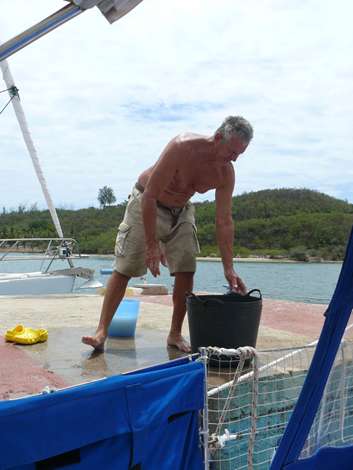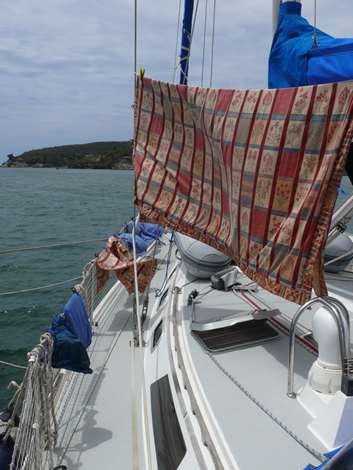ON TO CUBA 19:57.8N 75:52.6W

|
Whilst
we were in Isle a Vache our friends On Witte Raaf caught up with us. Joanna was fully recovered. We had spoken
to other cruisers who were returning from Cuba. They were all very enthusiastic.
Why not? To be so near and it was very unlikely that the opportunity would arise
again so we changed our mind overnight and headed towards Santiago de
Cuba. The
journey was 187 Nm. And in the log we entered “A very rough and painful
passage”! We had strong winds and big seas on the beam across The Windward
Passage. The main cabin was soaking. We had left the hatch covers on, the water
seeped through. We were
never more pleased to enter the protected waters of Santiago and to be welcomed
into the marina at Punta Gorda George
the duty harbourmaster, who spoke good English, despite never having travelled
anywhere, explained in detail the sequence of official visits to obtain “entry
permits” and visas. First the Doctor: Daniella a delightful young lady who
ascertained that we were ALIVE AND WELL. Charged us 30 cuc’s and gave us
permission to take down the yellow flag. She left with a smile on her face,
clutching well hidden cosmetics we had donated (difficult to obtain in Cuba and
extremely expensive). Next came Customs complete with a rather dopey looking
spaniel whose job it was to sniff out anything interesting on the boat. His
particular fancy was white powder but he left with a disappointed look on his
face. Two polite officers searched through bits of the boat but as it was late
Sunday afternoon they quickly lost interest and moved on: Cost 20 cuc’s.
George
returned with our passports and visas for 30 days, Cost: 15 cuc’s. The following
day we were visited by the two Carlos: Vet and Public Health. No animals on
board? Our rice and pasta were examined for wee beasties and given a clean bill
of health. 5 cuc’s for the vet. The only other charges were the cruising permit
20 cuc’s and entry fee 10 cuc’s. The officers were all very polite and correct.
It gave us a good feeling for our future time in Cuba.
George
also enlightened us on the rules and regulations regarding our stay in the
Marina. We may fraternise among the yachts on the Pontoon but at no time were
any Cubans allowed near any yachts!... Outside foreign visitors had to have
special permission to visit and pay a fee of 10 Cuc. At once we were reminded that we had to
watch our steps. We were under no illusion that this was a police run state. We
had so many eyes watching that we felt totally safe and no need to lock the
boat. Friendship with Cubans is not encouraged. No one
seemed flustered by the fact we had no local money. ‘Pay us whenever you go to
the bank in Santiago’, with difficulty we tried to understand the extraordinary
and unique Cuban currency system. Cuba’s National currency is the Peso, used to
pay Cubans’ salaries. The Peso Convertible (CUC) is used by visitors (it was
introduced in 1995 and has now completely replaced the US$). All official
tourist oriented facilities are charged in CUC. National peso can be spent in
markets to buy vegetables, fruits, meat etc. And of course local
buses! I Cuc = 24 Pesos = 0.80p. 1 peso =
3.3p. We decided to leave the complicated mathematics for another day. The first day after our arrival was spent clearing up the mess inside the boat. We had not been in a Marina since Trinidad therefore running was a bonus, but of course we are talking about Cuba, WHEN running, the water flow was very slow, still we managed and soon Scorch wa sparkling and
Two days
later we thought it was time to brave the outside of the Marina. We decided to
take the local bus (0.66p as opposed to £8 for the Official taxi) for the 13 km
to Santiago. In any case we always favour the buses as it is more fun, when they
turn up of course! No official time table so the wait can be either few minutes
to 2 hrs. The waiting passengers were very friendly and we practiced our
non-existent Spanish. By the time
we reached town the very old bus was full to capacity and we had our first
glimpse of Cuba and its people. |

 dry
again.
dry
again.